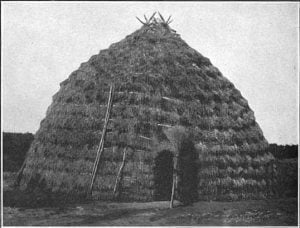Wichita Indians. From wits, “man.” Also known as:
- Black Pawnee, common early name.
- Do’gu’at, Kiowa name, meaning “tattooed people.”
- Do’kănă, Comanche name, meaning “tattooed people.”
- Freckled Panis, from above.
- Guichita, Spanish form of the name.
- Hin:4sso, Arapaho name.
- Höχsúwitan, Cheyenne name.
- Ki’-¢i-ku’-¢uc, Omaha name.
- Kirikiris, Kirikurus, or Kitikitish, reported as own name but properly the name of one of their bands.
- Mítsitá, Kansa name.
- Pá¢in wasábĕ, Ponca and Omaha name, meaning “Black bear Pawnee.”
- Paneassa, various early writers.
- Panis noirs, early French name.
- Panis piqués, early French name.
- Pányi Wacéwe, Iowa, Oto, and Missouri name.
- Picks, from Panis piqués.
- Pitchinávo, Comanche name, meaning “painted breasts.”
- Prickled Panis, referring to their tattooing.
- Quirasquiris, French form of native name.
- Quivira, from chronicles of Coronado expedition.
- Sónik’ni, Comanche name, meaning “grass lodges.”
- Speckled Pawnee, referring to their tattooing.
- Túχquĕt, see Do’gu’at.
Wichita Connections. The Wichita Indians were one of the principal tribes of the Caddoan linguistic family.
Wichita Location. Their earliest certain location was on Canadian River north of the headwaters of the Washita. (See also Texas.)
Wichita Subdivisions. Most of the so-called subdivisions of the Wichita were independent tribes, some of which, including the Tawakoni, Waco, Tawehash, and Yscani, have been treated separately. The others “Akwits or Akwesh, Kirikiris, Isis (see Yscani), Tokane (see Yscani), and Itaz” were probably only temporary bands. Mooney (1928) also mentions the Kirishkitsu (perhaps a Wichita name for the Kichai) and the Asidahetsh and Kishkat, which cannot be identified.
Wichita History. The Wichita rose to fame at an early period owing to the fact that they were visited by Coronado in 1541, the Spaniards calling the Wichita country the province of Quivira. They were then farther north than the location given above, probably near the great bend of the Arkansas and in the center of Kansas. A Franciscan missionary, Juan de Padilla, remained 3 years among them in the endeavor to convert them to Christianity, but he was finally killed by them through jealousy on account of his work for another tribe. In 1719 La Harpe found the Wichita and several allied tribes on the south Canadian River in the territory later embraced in the Chickasaw Nation. Within the next 50 years they were forced south by hostile northern and eastern tribes and by 1772 were on the upper courses of the Red and Brazos Rivers. In 1835 they made their first treaty with the United States Government. They continued to live in southwestern Oklahoma until the Civil War, when they fled to Kansas until it was over. In 1867 they returned and were placed on a reservation in Caddo County, Oklahoma, where they have since remained.
Wichita Population. In 1772 the Wichita and the Tawehash seem to have had about 600 warriors. Mooney (1928) estimates that in 1780 the confederated Wichita Indians had a population of about 3,200. Bolton (1914), on information derived from Mézières, estimated about 3,200 for the Wichita proper in 1778. In 1805 Sibley estimated the Wichita at 400 men. In 1868, 572 were reported in the confederated tribes. The census of 1910 gives 318, including the remnant of the Kichai. In 1937 there were 385.
Connection in which the Wichita have become noted. Although a tribe of considerable power in early days, the Wichita will be remembered in future principally from the prominence of the city of Wichita, Kans., which bears their name. It is also the name of counties hi Kansas and Texas, a ridge of hills in southwestern Oklahoma called the Wichita Mountains, a river in Texas, and places in Oklahoma, besides Wichita Falls in Wichita County, Tex. The identification of this tribe with the Province of Quivira gives it additional interest.

